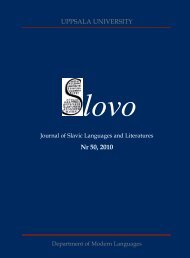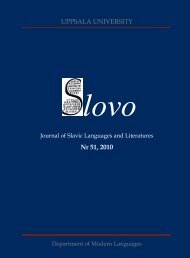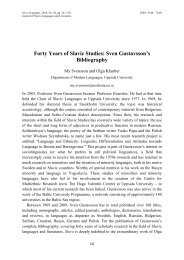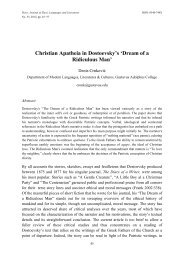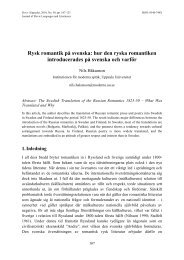Full text PDF - Index of - Uppsala universitet
Full text PDF - Index of - Uppsala universitet
Full text PDF - Index of - Uppsala universitet
Create successful ePaper yourself
Turn your PDF publications into a flip-book with our unique Google optimized e-Paper software.
Slovo.<br />
Journal <strong>of</strong> Slavic Languages and Literatures<br />
The English construction in (42) has most semantic elements overtly expressed<br />
except the higher imperfective. The embedded infinitival predicate “to be talking”<br />
does not have any morphological tense features, and it is therefore semantically<br />
tenseless and compatible with any temporal interpretation inherited from the higher<br />
predicate.<br />
However, the embedded non-finite verb form overtly expresses the lower<br />
progressive aspect: be talking. Furthermore, in the English sentence we find an<br />
additional quantifying element: always. This points to an element <strong>of</strong> the construction<br />
that is neglected in this paper (since it is orthogonal to the main plot), namely the<br />
question <strong>of</strong> determining what intervals are relevant for the instantiation <strong>of</strong> the events<br />
denoted by the VP. In the paraphrase in (43) above, I use the vague expression<br />
“con<strong>text</strong>ually relevant subintervals” <strong>of</strong> the habitus. Indeed, con<strong>text</strong> is a key factor, and<br />
the overt quantifier “always” must be further restricted to, say, “every time … after<br />
breakfast on a sunny day…” or something similar. I assume that the quantification<br />
over con<strong>text</strong>ually relevant times originates with the habitual operator 12 , which<br />
therefore binds the reference time <strong>of</strong> the VP and thus takes a semantically tenseless VP<br />
as input. We have temporal control, but the event variable remains independent <strong>of</strong> the<br />
habituality operator HAB (hence two independent aspects).<br />
The fact that the embedded VP is semantically tenseless makes it all the more<br />
natural that used to in English and similar quantifiers in other Germanic languages<br />
embed an infinitive complement (non-finite with respect to tense, i.e. tenseless, but<br />
possibly marked for aspect as in (42)). There is not much room for a semantic tense<br />
under a tensed habituality operator. Nevertheless, for Russian we have to justify the<br />
tense morphology (present tense) <strong>of</strong> the finite embedded predicates, and this is why we<br />
need the licensing condition depicted in Figure 4: tenseless propositions (VPs) have<br />
the feature “interpretable now” [in].<br />
7. “Perfective present” in Russian habituals<br />
With the SOT parameter we can finally provide an explanation for data such as the<br />
following, repeated from (28) above:<br />
(45) Я ходил к ней и по человечности носил ей чайку, сахарку. А она,<br />
бывало[up, uipf], увидит[un, upf], меня и начнет[un, upf], трястись всем<br />
телом, машет[un, uipf], руками и бормочет: “Уйди!” (Anton Čechov,<br />
“Baby”)<br />
In the traditional literature on Slavic aspect, this use <strong>of</strong> the perfective aspect under an<br />
overt or covert byvalo is known as the primerno-nagljadnoe značenie (e.g. Bondarko<br />
12 See Scheiner 2002 for a more fine-grained analysis on this point.<br />
74



